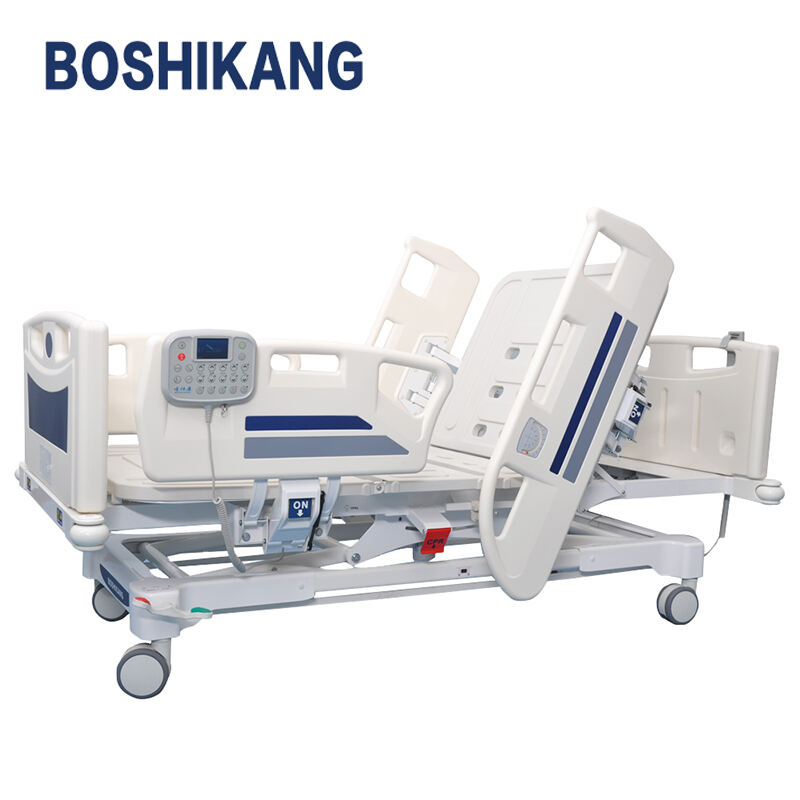Selecting the appropriate medical bed for your healthcare facility represents one of the most critical decisions affecting patient care quality and operational efficiency. Modern healthcare environments demand sophisticated equipment that balances patient comfort, clinical functionality, and cost-effectiveness. Healthcare administrators must consider numerous factors when evaluating medical bed options, from basic manual models to advanced electric systems with integrated monitoring capabilities. The right choice can significantly impact patient recovery outcomes, staff productivity, and overall facility reputation while ensuring compliance with stringent healthcare regulations and safety standards.

Understanding Medical Bed Categories and Classifications
Standard Hospital Bed Configurations
Standard hospital beds form the foundation of most healthcare facilities, offering essential positioning capabilities for general patient care. These beds typically feature adjustable head and foot sections, allowing caregivers to position patients for optimal comfort during recovery. The frame construction utilizes durable steel or aluminum materials designed to withstand frequent use and rigorous cleaning protocols. Side rails provide essential patient safety while facilitating easy access for medical procedures. Weight capacity considerations ensure accommodation of diverse patient populations while maintaining structural integrity throughout extended service periods.
Manual adjustment mechanisms offer reliable functionality with minimal maintenance requirements, making them suitable for budget-conscious facilities. The simplicity of manual controls reduces potential technical failures while ensuring consistent operation across different staff skill levels. However, manual systems require physical effort from healthcare workers, potentially contributing to workplace injuries and reduced efficiency during busy periods. Understanding these trade-offs helps administrators make informed decisions based on specific facility needs and resource limitations.
Advanced Electric Medical Bed Systems
Electric medical beds represent the evolution of patient care technology, incorporating sophisticated motor systems and electronic controls for precise positioning. These systems enable effortless adjustment of bed height, head elevation, foot positioning, and Trendelenburg angles through intuitive control panels. Advanced models integrate additional features such as built-in scales, cardiac chair positioning, and programmable memory settings for individual patient preferences. The enhanced functionality significantly reduces caregiver workload while improving patient comfort and treatment outcomes.
Modern electric beds incorporate safety features including battery backup systems, emergency lowering mechanisms, and lockout controls to prevent unauthorized adjustments. Integrated technology platforms may include patient monitoring capabilities, nurse call systems, and electronic medical record connectivity. While initial investment costs exceed manual alternatives, the long-term benefits in terms of staff efficiency, patient satisfaction, and clinical outcomes often justify the additional expense for many healthcare facilities.
Critical Technical Specifications and Features
Weight Capacity and Structural Considerations
Medical bed weight capacity specifications directly impact patient safety and equipment longevity, requiring careful evaluation during the selection process. Standard beds typically accommodate patients weighing up to 350-450 pounds, while bariatric models support individuals exceeding 600 pounds. The frame construction must withstand not only static patient weight but also dynamic forces generated during patient movement, medical procedures, and emergency situations. Reinforced support structures and upgraded motor systems ensure reliable performance under challenging conditions.
Structural durability extends beyond weight capacity to include materials selection, welding quality, and component integration. Hospital-grade steel frames provide exceptional strength while resisting corrosion from frequent cleaning and sanitization procedures. Aluminum alternatives offer reduced weight for improved mobility while maintaining adequate strength for most applications. Quality manufacturers conduct rigorous testing protocols to validate structural integrity under simulated clinical conditions, providing confidence in long-term performance and patient safety.
Positioning Capabilities and Range of Motion
Comprehensive positioning capabilities enhance patient comfort while supporting diverse clinical protocols and treatment requirements. Head section elevation ranges typically extend from flat positioning to 80-degree angles, accommodating respiratory therapy, feeding procedures, and general comfort needs. Foot section adjustment enables leg elevation for circulation improvement and wound care access. Advanced models incorporate independent knee break functionality, allowing precise lower leg positioning without affecting thigh support.
Height adjustment ranges facilitate both patient care and caregiver ergonomics, with typical specifications spanning 8-32 inches from floor level. Low positioning assists with patient transfers and reduces fall injury severity, while elevated positions improve caregiver access during procedures. Trendelenburg and reverse Trendelenburg positioning capabilities support specialized medical protocols including shock treatment and surgical procedures. The smooth, quiet operation of adjustment mechanisms ensures patient comfort during positioning changes while minimizing disruption in shared rooms.
Safety Standards and Regulatory Compliance
FDA Regulations and Medical Device Classifications
Medical bed safety standards encompass comprehensive regulatory frameworks designed to protect patients and healthcare workers from potential hazards. The Food and Drug Administration classifies medical beds as Class II medical devices, requiring manufacturers to demonstrate substantial equivalence to predicate devices through 510(k) submissions. These regulations mandate rigorous testing protocols covering electrical safety, mechanical integrity, and biocompatibility requirements. Compliance documentation provides healthcare facilities with assurance that equipment meets established safety benchmarks and performance criteria.
International standards including IEC 60601 series specifications address electrical safety requirements for medical electrical equipment. These standards define acceptable leakage currents, insulation requirements, and electromagnetic compatibility parameters essential for safe operation in clinical environments. Manufacturers must provide comprehensive risk management documentation demonstrating hazard identification, risk assessment, and mitigation strategies throughout the product lifecycle. Regular safety updates and recalls ensure ongoing compliance as standards evolve and new safety concerns emerge.
Infection Control and Cleaning Protocols
Effective infection control requires medical bed designs that facilitate thorough cleaning and disinfection procedures. Surface materials must withstand repeated exposure to hospital-grade disinfectants without degradation or harbor bacterial growth in microscopic crevices. Seamless construction eliminates potential contamination sites while removable components enable thorough sanitization between patients. Antimicrobial coatings and materials provide additional protection against pathogen transmission in high-risk environments.
Cleaning protocol compatibility ensures that beds can undergo required disinfection procedures without compromising functionality or appearance. Electrical components require appropriate ingress protection ratings to prevent moisture damage during cleaning operations. Quick-release mechanisms for mattress platforms and side rails streamline turnaround processes between patients while ensuring complete decontamination. Documentation of approved cleaning agents and procedures helps maintain warranty coverage while ensuring compliance with facility infection control policies.
Cost Analysis and Budget Planning
Initial Investment Considerations
Medical bed procurement requires comprehensive cost analysis extending beyond initial purchase prices to include installation, training, and integration expenses. Basic manual beds may cost $1,500-$3,000 per unit, while advanced electric models range from $5,000-$15,000 depending on feature complexity and manufacturer specifications. Bulk purchasing agreements often provide significant cost savings for facilities requiring multiple units, while lease options may better align with budget constraints and technology upgrade cycles.
Hidden costs include staff training requirements, maintenance contracts, and potential facility modifications needed for electrical or data connectivity. Integration with existing hospital information systems may require additional software licensing and technical support services. Transportation, assembly, and commissioning services add to total project costs while ensuring proper installation and initial operation. Comprehensive budget planning accounts for these ancillary expenses to prevent unexpected financial impacts during implementation.
Long-term Operational Costs and ROI
Total cost of ownership calculations must incorporate maintenance expenses, energy consumption, and replacement part availability over the expected equipment lifecycle. Electric beds typically require more frequent maintenance due to motor systems and electronic components, while manual beds offer lower ongoing costs with primarily mechanical maintenance needs. Energy consumption varies significantly between models, with efficient LED lighting and standby power management features reducing operational costs over time.
Return on investment metrics include quantifiable benefits such as reduced staff injuries, improved patient satisfaction scores, and decreased length of stay statistics. Enhanced positioning capabilities may reduce pressure ulcer incidents, resulting in significant cost savings through avoided treatment expenses and regulatory penalties. Improved workflow efficiency enables higher patient throughput while reducing overtime expenses. These tangible benefits often justify higher initial investments in advanced medical bed systems for facilities focused on operational excellence and patient outcomes.
Technology Integration and Future-Proofing
Smart Bed Technologies and IoT Connectivity
Contemporary medical beds increasingly incorporate Internet of Things connectivity and smart sensor technologies to enhance patient monitoring and care delivery. Integrated weight sensors provide continuous patient monitoring while detecting movement patterns that may indicate fall risks or health status changes. Environmental sensors monitor bed-specific conditions including temperature, humidity, and air quality parameters. Data integration with electronic health records enables comprehensive patient monitoring while supporting evidence-based care decisions.
Wireless connectivity facilitates remote monitoring capabilities, allowing healthcare staff to track multiple patients simultaneously from central monitoring stations. Predictive maintenance algorithms analyze usage patterns and component performance to schedule proactive maintenance before failures occur. These capabilities reduce unexpected downtime while optimizing maintenance resource allocation. Cloud-based data analytics provide insights into utilization patterns, helping administrators optimize bed allocation and facility planning decisions.
Upgradeability and System Compatibility
Future-proofing strategies ensure that medical bed investments remain viable as technology standards and clinical requirements evolve. Modular design approaches enable component upgrades without complete system replacement, extending useful life while incorporating new capabilities. Standard communication protocols ensure compatibility with emerging healthcare information systems and medical device networks. Software update capabilities allow feature enhancements and security improvements throughout the equipment lifecycle.
Interoperability standards including HL7 FHIR and DICOM ensure seamless integration with existing hospital information systems and future technology adoptions. Open architecture designs prevent vendor lock-in situations while providing flexibility for future system modifications. Comprehensive documentation of interface specifications and API capabilities supports custom integration projects and third-party device connectivity. These considerations ensure that medical bed investments continue providing value as healthcare technology landscapes evolve.
FAQ
What is the typical lifespan of a medical bed in a healthcare facility
Medical beds typically provide 10-15 years of service life when properly maintained and operated within manufacturer specifications. Manual beds often exceed this range due to fewer mechanical components, while electric beds may require major component replacements or upgrades during this period. Regular preventive maintenance, proper staff training, and adherence to weight capacity limits significantly impact longevity. Facilities should plan for gradual replacement cycles rather than simultaneous fleet updates to manage budget impacts and ensure continuous service availability.
How do bariatric beds differ from standard medical beds
Bariatric beds feature reinforced frame construction, expanded width dimensions, and higher weight capacity ratings to safely accommodate larger patients. These beds typically support 600-1000 pounds compared to 350-450 pounds for standard models. Enhanced motor systems provide adequate lifting power for positioning heavier patients, while wider platforms ensure patient comfort and safety. Additional features may include reinforced side rails, heavy-duty casters, and specialized mattress support systems designed for bariatric patient care requirements.
What maintenance requirements should facilities expect for electric medical beds
Electric medical beds require scheduled maintenance including motor lubrication, electrical connection inspection, and control system calibration. Battery backup systems need periodic testing and replacement every 3-5 years depending on usage patterns. Software updates may be required to maintain security and feature compatibility with hospital information systems. Most manufacturers recommend professional service every 6-12 months, with daily cleaning and basic inspection performed by facility staff. Comprehensive maintenance contracts often provide cost-effective coverage including emergency repairs and replacement parts.
Can medical beds integrate with existing hospital information systems
Modern medical beds increasingly offer integration capabilities with hospital information systems through standard communication protocols and wireless connectivity. Integration enables automatic patient data collection, alarm notification, and workflow optimization features. Compatibility depends on specific bed models and hospital system architectures, requiring technical evaluation during procurement planning. Successful integration may require additional software licensing, network infrastructure upgrades, and staff training programs. Healthcare IT departments should be involved early in the selection process to ensure compatibility and optimal system performance.


